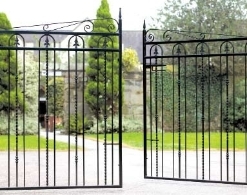Wrought Iron Gates Measuring Guide
How to Measure the Opening for Different Wrought Iron Gate Installation Types
Before selecting the product, we encourage you to thoroughly read our wrought iron gate measurement guide. This is to ensure that you are fully aware of how our product dimensions are listed and guarantee you have the proper understanding of how to measure the opening correctly. We believe the following information will be precious to homeowners and installers alike. However, if you have additional questions about any of the data provided, please contact us at your convenience.
Installing a Single Gate Between Existing Brickwork

How To Measure the Opening
If you need to install our single gates between an existing structure (such as a brick wall) you can establish the correct size to order as follows:
-
Measure the gap between the existing brick walls.
-
This dimension will become your ordering size.
-
You should then find a gate shown online with a "fits opening" size listed in the drop-down menu that matches this measurement.
-
If you cannot find the size you need shown online, you will need a made to measure size.
Examples
-
If your gap measures 914mm, you should order a gate to "fit opening" 914mm.
-
If the gap size is 900mm you will need a made to measure size as this is not a standard size option we offer.
Top Tips
-
The gap size always determines the ordering size.
-
The "fits opening" size displayed in the drop-down menu already includes the space required for the hinges and latch.
-
We recommend measuring the aperture in three locations while obtaining measurements (top, middle and bottom). If there is a difference in size, the smallest dimension will be the size you need to use.
-
To avoid the need for a made-to-measure size, you can adjust your opening to suit a standard gate by installing metal posts, timber strips, or other similar materials onto the brickwork.
-
You must ensure that the brickwork is suitable to attach the hinge brackets and receiver plate for the latch. Failure to do so can lead to unacceptable levels of support for the gate.
-
The opening size (width between brickwork) should not be confused with the actual width of the gate.
-
Concerning the height dimensions we display on the product pages, we have made no provision for ground clearance if the description refers to "physical height."
Installing a Single Gate Using New Metal Posts

When there is no existing structure to hang the gate, you will need to install metal posts of the correct size, type and design to suit the gate you order.
How to Measure the Opening
If you installation will involve the provision of new metal posts, you should complete the following:
-
Measure the total space you have available.
-
Deduct the width of the posts from this measurement (the post sizes are displayed in the options and accessories menu on each product page).
-
The measurement that remains will become the width you need to order.
-
You should then find the gate shown online with a "fits opening" size listed in the drop-down menu that matches this measurement.
-
If you cannot find the size you need shown online, you will need a made to measure size.
Examples
-
If your total space measures 1320mm, and the gate you want to order has the option of using 50mm posts, you calculate 1320mm - 100mm = 1220mm. You should then order a gate to "fit opening" 1220mm together with 2 x 50mm metal posts (as this will make up a total overall space of 1320mm).
-
If your total space measures 900mm, and the gate you want to order has the option of using 50mm posts, you calculate 900mm - 100mm = 800mm. The "fits opening" measurement is 800mm, but this is not a standard size; therefore, you will require a made to measure size.
Top Tips
-
The gap size between the posts always determines the ordering size of the gate.
-
The "fits opening" size displayed in the drop-down menu already includes the space required for the hinges and latch.
-
The overall space minus the width of the posts will form the "fits opening" width of the gate you need to order.
-
To avoid the need for a made-to-measure size, you can adjust the position of your posts. However, this may not always be possible.
-
Posts must be sunk into the ground to the correct depth and securely held with concrete.
Installing Driveway Gates & Estate Gates Between Existing Masonry

How To Measure the Opening
When installing driveway gates and estate gates between existing masonry structures such as brick pillars, you will need to measure the opening as follows:
- Measure the distance between the existing brick walls.
- This dimension will become your ordering size.
- The size you then order (from the "fits opening" menu on the product page) should match this measurement.
- If you cannot locate the size you require shown online; please feel free to contact us to get a quote for a made to measure size.
Examples
- If your opening between walls measures 3048mm, you should order the gates to "fit an opening" 3048mm.
- If the gap size is 3000mm, you will require a made to measure size as this is not a standard size option.
Top Tips
- The gap size is always the same as the "fits opening" ordering size.
- The "fits opening" size displayed in the drop-down menu already includes the space required for the hinges and latch.
- We recommend measuring the gap in three positions while obtaining measurements (top, middle and bottom). If there is a discrepancy in width, the smallest measurement will be the size you need to use.
- To avoid ordering a made to measure size, you can reduce the opening to suit standard gates. You can install metal posts, timber strips, or other similar materials onto the brickwork.
- You must ensure that the brickwork is suitable to attach the hinge brackets. Failure to do so can lead to unacceptable levels of support for the gates.
- The opening size (the gap between brickwork) should not be confused with the actual width of the gates.
- We have made no provision for ground clearance for the height measurements displayed on the product pages if the description refers to "physical height."
Installing Driveway Gates & Estate Gates Using New Metal Posts
For any freestanding double gate installation that lacks existing masonry support, you will need to install metal posts to provide support for the hinges.
How to Measure the Opening
If your installation requires metal posts, you should complete the following steps:
-
Measure the entire space you have available to fit the gates and posts.
-
Subtract the width of the posts from this measurement (the post dimensions are displayed in the options and accessories menu on each product page).
-
The measurement that remains will become the width you need to order.
-
You can then find gates shown online with a "fits opening" size listed in the drop-down menu that matches this measurement.
-
If you cannot find the width you require online, you will need a made to measure size.
Examples
-
If your total space measures 3493mm, and the gates you want to order contains the option of using 70mm posts, you calculate 3493mm (overall length) - 140mm (width of 2 x posts) = 3353mm. You should then order the gate to "fit opening" 3353mm together with 2 x 70mm metal posts (as this will make up a total overall space of 3353mm).
-
If your total space measures 3800mm, and the gates you want have the option of using 100mm posts, you calculate 3800mm - 200mm (width of 2 x posts) = 3600mm. The "fits opening" measurement is therefore 3600mm, but this is not a standard size so that means you will need made-to-measure gates.
Top Tips
- The gap size between the posts always determines the ordering size of the gate.
- The "fits opening" size displayed in the drop-down menu already includes the space required for the hinges and latch.
- The overall space minus the width of the posts will form the "fits opening" width of the gates you need to order.
- To avoid the need for a made-to-measure size, you can adjust the position of your posts. However, this may not always be possible.
- Posts must be dropped into the ground to the correct depth and securely held with concrete.




